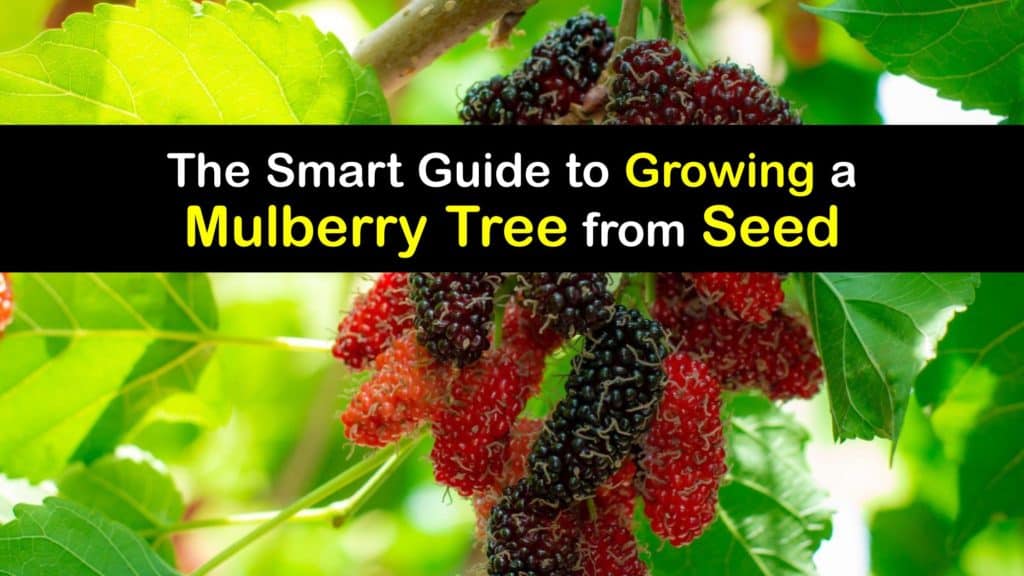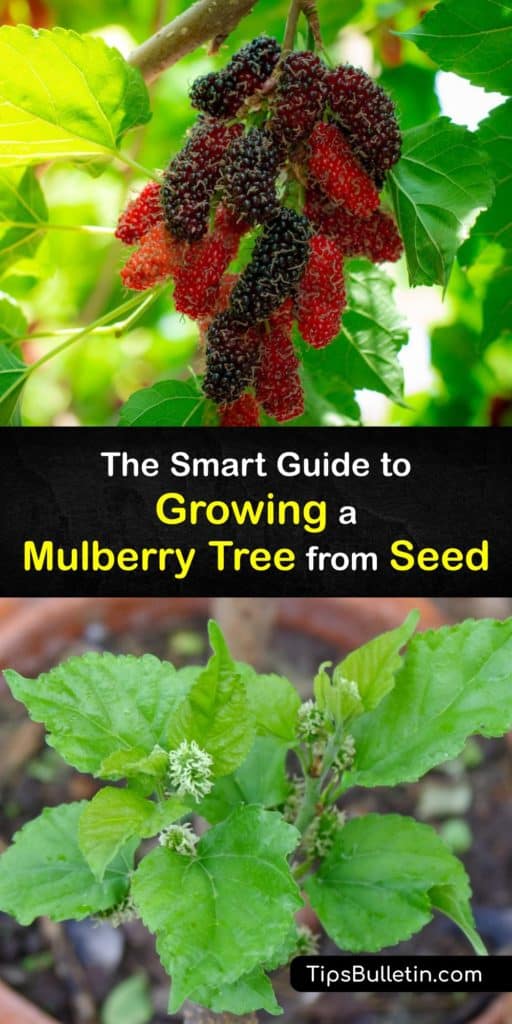In North America, you’re most likely to encounter a white mulberry tree (Morus alba or M alba) rather than the native red mulberry tree (Morus Rubra) or a hybrid. Mulberries have a black fruit that tastes great in wine or mulberry juice and a leaf with pharmacological and health benefits, so it’s no surprise many gardeners want to know how to grow a mulberry tree from seed.
Mulberry cultivation is a pleasurable activity with a long history. Before the American Revolution, the English shipped white mulberry plants to North America. They began growing mulberry trees to establish a food supply for a silkworm process in the fledgling American textile industry.
The number of white mulberry trees has increased due to the species’ high germination and spread efficiency. On the other hand, the characteristic native red mulberry tree (Morus rubra) is a deciduous tree endemic to North America, notably North Carolina, but a rare sight in nature.

- Everything to Know to Grow Mulberry Trees
- Best Types for Growing Mulberry Trees at Home
- When to Start Growing Your Mulberry Trees
- How to Grow a Mulberry Tree from Seed – Germination
- Transplanting Mulberry Seedlings
- Care When Growing Mulberry Trees
- Pruning Mulberry Trees
- How Tall Do Mulberry Trees Grow?
- Harvest and Storage When You Grow Mulberry Trees
Everything to Know to Grow Mulberry Trees
Mulberry trees are deciduous and make lovely landscape additions if adequately cared for. Dark green lobed leaves and blackberry-like berries characterize the red and white varieties and hybrids.
Discover how to grow a mulberry tree from seed and mulberry leaves with serrated edges. Grow mulberry trees for shade, aesthetics, and mulberry fruit. It’s simple to grow mulberry trees if gardeners understand how to grow a mulberry tree from seed and the primary care requirements for growing mulberry trees.
Mulberries are the ideal summertime snack – even better if you pluck handfuls of these fragrant, black fruits from your own mulberry tree.
Water makes up 88 percent of the weight of fresh mulberries. They are a low-calorie fruit with only 60 calories in each ripe and succulent cup of fruit. Dried mulberries for eating like raisins are popular.
Mulberry has one of the most significant protein levels compared to most other berries. Potassium, iron, vitamins C, E, and K1 are abundant in these berries.
The mulberry bush has a lot of roots that develop quickly. Grow mulberry tree cuttings and seeds away from structures such as the garage or foundation and plumbing or water lines to avoid the root ball disrupting your property’s critical features.
Check the growing guide for the tree’s mature height and choose a location where minimal pruning is necessary, as mulberry trees are sensitive to pruning. The mulberry fruit tree develops organically for optimum berry yield if left unpruned. Mulberries are easy to grow and harvest, and their berries are delicious.

Best Types for Growing Mulberry Trees at Home
To grow mulberry trees, pick which variety best suits your garden and goals. There are many different mulberry types to choose from, including white, black, and red mulberry.
Before acquiring flower seed, mulberry cuttings, or a seedling for your garden, decide which mulberry variety to plant. Settlers developed white mulberry trees for raising silkworms, not for their fruit. White mulberries contain a single-note sweetness with no counterbalancing tartness, making them edible.
Red mulberries, like white mulberries, are sweet, but black mulberries, have a balanced acidity. If you want to raise mulberry trees to eat the fruit, black mulberries taste the best and produce the most fruit. The sweetness of the berries mutes the tanginess.
When to Start Growing Your Mulberry Trees
While early spring is the optimum time for growing mulberry trees, it’s also good to do so when the weather isn’t too hot or chilly. Early spring and fall are the most popular times to plant a blackberry tree vs mulberry tree, with summer plantings being an alternative in areas with cooler summer temperatures.
Plant a young tree in early spring when the soil is workable and mature mulberry trees are inactive for bare-root trees. Plant container mulberry trees or mulberry seeds in spring or early summer before the hot, dry season starts. Mulberry tree plants are grown in mild-winter locales by planting mulberry seeds in the fall.
How to Grow a Mulberry Tree from Seed – Germination
Planting mulberry trees begins with high-quality mulberry seeds purchased from your local garden store. Fill a tray with an equal mixture of soil, peat, and perlite. Plant the seeds just below the soil surface and water until the earth is moist. Keep them warm – around 85°F during the day and 65°F at night.
Use a heat light if necessary. Allow the seeds to be exposed to sunlight for at least eight hours per day. Check the soil moisture daily and water if it feels dry to the touch.
Check for germination after 14 days. As soon as roots form, remove the mulberry sprouts. Roots are delicate, and longer roots are more easily damaged during the transplanting process, so it’s best to perform this early.
To give the seeds enough room to grow into seedlings, transplant them into individual pots with a minimum of four inches between each plant. When there is a risk of frost, keep pots in the same environment as the seeds.
The pots may be put outside in a sunny location if there is no threat of freezing. Keep the soil moist by watering well once a week. The seedlings will be large enough to relocate to their permanent location in the garden in 12 to 24 months.
Transplanting Mulberry Seedlings
If you intend to plant a sapling grown from seed, wait until after the growing season’s last frost. Dig a hole in your tree’s final location deeper than its current container to ensure a good planting depth for your young tree.
Gardeners may use cuttings from existing trees to start a new mulberry plant. Remove 8 to 12 inch long branches of a healthy tree at its regular pruning time. At least three buds should be present on each twig.
Bury the cuttings as quickly as possible, preferably in late spring, by covering them in the soil to 3-4 inches. Keep newly transplanted mulberry trees wet for at least a month by watering them daily.
It’s also possible to grow your mulberry tree in a fruit tree planter as long as it’s large enough and placed in the right location.
Care When Growing Mulberry Trees
Give your tree lots of water to aid in developing a solid root system. Provide your mulberry plant with roughly three gallons of water per week for the first year. Once established, mulberry trees are drought resistant, yet extended dry weather diminishes ripe fruit supply, induces leaf withering, and causes berries to drop before they ripen.
Feed the young tree once a year in the winter to keep it healthy and produce good fruit. Your plant will get the nutrients it needs to grow by absorbing manure tea.
To use this mulberry fertilizer, mix well in late winter and apply manure tea to the soil.
Mulberry trees are not immune to mulberry problems. Watch for disease and insect pests and treat them promptly. Get rid of aphids on trees with a neem oil drench or diatomaceous earth.
A male tree has flowers containing pollen to fertilize female flowers and allow them to grow fruit. Thankfully, taking care of a female or male tree is the same. As long as the ground is well-drained, mulberry trees are adaptable and may grow in many soil types, including loamy, clay, and sandy soil.
The trees thrive in a wide pH range, from neutral to slightly acidic. Most mulberry trees are cold tolerant and endure temperatures as low as -25°F during dormancy. However, they yield the most fruit when the temperature is between 68-86°F.
Pruning Mulberry Trees
The mulberry tree is one of the simplest to maintain, requiring only minor pruning throughout the winter months. Only remove the branches if they are injured or diseased, and never trim trees while producing sap.
Check the status of your tree while performing regular lawn care. If you notice the tree weeping with liquid seeping out at any point, don’t prune it until sap production stops.
The mulberry might quickly turn from a delight to a nuisance if not kept in check once it reaches maturity. These trees have been dubbed weeds in many places because they spread quickly and grow between sidewalk tiles or into the foundations of houses.
If invasive saplings aren’t removed while they’re still young, the root systems cause damage to anything in their path. Check around the base of your mulberry trees regularly for new saplings. Pull and destroy any young trees you don’t want to allow to reach maturity.
Mulberries are beautiful with their dark green leaf and various colored fruits, but they quickly become a nightmare when they take over gardens, invade structures and proliferate out of control.
How Tall Do Mulberry Trees Grow?
All three species of deciduous trees grow to different heights. The white mulberry reaches 80 feet, the red mulberry 70 feet, and the lesser black mulberry 30 feet. Black mulberry trees live for hundreds of years, while red mulberries have a maximum lifespan of 75 years.
All mulberry fruit trees prefer full sun and rich soil but grow in various conditions. They’re simple to transplant, salt resistant, and ideal for erosion management, not to mention the tasty berries. Some cultivars are resistant to wind and make excellent windbreaks.
Plant mulberry trees in full sun with at least 15 feet between trees. Many gardeners forget to consider the consequential staining from fallen berries, easily tracked into the house. Avoid planting mulberry trees near entrances and sidewalks if this is an issue.
Harvest and Storage When You Grow Mulberry Trees
After understanding how to grow a mulberry tree from seed, many growers wonder how long it takes to bear fruit. To begin picking mulberries takes three years. Mulberry harvesting season runs from June to August.
Mulberry fruit is easy to pick and falls from the tree unexpectedly. As a result, the ideal way to harvest mulberries is to lay an old blanket around the tree’s base and slowly rock the branches above. You’ll have lots of fruit falling from your tree with little work.
Mulberries don’t store well, so eat, bake with, or preserve berries right away after you harvest mulberries. Because removing the stems and mulberry seeds is complex, the fruits are eaten whole. Before eating a ripe fruit raw, give it a short rinse to remove any dirt or insects.
Though they are sometimes mistaken for berries, the mulberry fruit is a collective fruit; growers may use it in any cuisine calling for berries. Mulberries are highly juicy, so expect your dishes to be watery. However, unlike other berries, they do not respond well to drying.
Mulberry trees are popular as decorative shade trees and for their abundant edible fruit. Consume the berries raw or make delectable preserves, pies, and wine. Mulberry trees give shade in the summer and attract a range of fruit-loving birds and provide tasty, colorful fruit.
Bees and butterflies love to visit any yard in the spring where a tree is packed with berries. Mulberry trees are known for their low maintenance requirements, though it’s worth noting they are invasive, and growers should give thought before adding them to a garden.
If you’re ready to grow mulberry trees understanding the basics of how to grow a mulberry tree from seed ensures success. Growing mulberry trees is an excellent long-term project to add landscaping, shade, and delicious, versatile produce to your home harden.

If you loved this article on how to grow a mulberry tree from seed, please share these great tips for growing mulberry trees with your friends and family on Pinterest and Facebook.